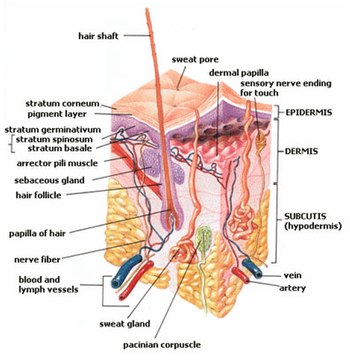Sweaty hands
| Classification according to ICD-10 | |
|---|---|
| R61.0 | circumscribed hyperhidrosis |
| ICD-10 online (WHO version 2019) | |
When welding hands , or medically hyperhidrosis palmar , the excessive is sweating in the hands , respectively. This is mostly limited to the palms of the hands and is often associated with high psychosocial pressure, including restrictions in choosing a career or partner. People who suffer from a lot of hand sweat often withdraw from everyday life in order to avoid situations that are perceived as personal stress, such as shaking hands (with sometimes dripping wet hands). Compared to other forms of profuse sweating, excessive sweating on the hands is considered to be one of the most psychologically stressful forms of hyperhidrosis, because sweating on the palms is comparatively difficult to treat and in everyday life it is difficult to hide from contact persons due to the lack of covering (exception: gloves in the winter).
Sweaty hands in themselves are not automatically a sign of a lack of self-confidence , severe nervousness or fear , but these conditions can be triggered or exacerbated. In some cases, those affected get caught in a vicious circle of sweating , fear of sweating and the resulting sweating.
root cause
Extreme hand sweat, like hyperhidrosis itself, usually only occurs during puberty. In a representative survey of over 3000 people questioned, 46.6% stated that hyperhidrosis did not break out until puberty.
Anatomical and physiological basics
The soles of the feet and palms are covered with a particularly large number of eccrine sweat glands , usually around 500 per cm². These are not used for thermoregulation , but for better adhesion. This can also be seen in the fact that the corresponding sweat production of the hands and feet is not controlled by the thermoregulatory center , but by a separate center of the central nervous system via the sympathetic part of the autonomic nervous system. The sweating of the hands and feet (palmoplantar) is mediated by sympathetic nerve fibers and does not occur during sleep.
Overactive sweat glands
An overactivity of the autonomic nervous system and an abnormal size of the sweat glands are seen as the causes of increased perspiration, which can be influenced by other factors. The increased sweating all over the skin is known as general hyperhidrosis . A localized hyperfunction (focal form) usually occurs in the area of the armpits ( hyperhidrosis axillaris ) or the hands ( hyperhidrosis palmaris ) and also the feet ( hyperhidrosis plantaris ).
In the case of sweaty hands, the horny layer of the skin is often very moisturized due to increased sweating, which often leads to the skin drying out if sweating is temporarily reduced to a normal level (e.g. overnight). When dry, the palms appear cracked and the skin can tend to blister.
diagnosis
Overactive sweat glands on the hands can be measured by applying an iodine tincture and, after drying, powdering it with potato starch . Since the sweat that escapes changes the brushed and powdered surface significantly by turning it blue, the intensity of this color change also shows the individual characteristics of the sweaty hands . This test is also suitable for monitoring the progress of therapy.
Skin status
In addition to increased bacterial colonization, there is often visible contamination of the palms of the hands. Wet hands react as effectively as a damp cleaning rag to the absorption of environmental dirt such as dust, fibers and other smaller substances. This effect becomes particularly clear when a person suffering from hand perspiration puts their hands on z. B. immersed in fine sand; The result of this experiment will have an optical effect similar to that of breading , whereby the palm of the hand will hardly be visible due to the high adhesion of the sand , which is now soaked with sweat .
Medical therapy
A professional medical therapy is usually carried out, if necessary, in the following order (see also hyperhidrosis ):
- Aluminum chloride therapy
- Tap water iontophoresis
- Injection of botulinum toxin (botox) into the skin of the palm (intradermal) under light anesthesia at intervals of about six months
- CT-assisted lumbar sympathicolysis
- Here, phenol is injected into the ganglion of the sympathetic trunk at the Th12 on both sides under local anesthesia . The sweating on the hands then remains - with successful therapy - on average for a full year.
Individual evidence
- ^ RK Achenbach: Hyperhidrosis. Springer-Verlag, 2013, ISBN 978-3-798-51945-9 , p. 132.
- ↑ Survey result “Since when have you been sweating heavily?” ( Memento of the original from September 25, 2008 in the Internet Archive ) Info: The archive link was inserted automatically and has not yet been checked. Please check the original and archive link according to the instructions and then remove this notice. (As of December 9, 2008)

